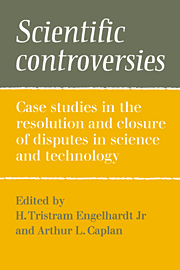 Scientific Controversies
Scientific Controversies Book contents
- Frontmatter
- Contents
- Preface
- List of contributors
- Introduction: Patterns of controversy and closure: the interplay of knowledge, values, and political forces
- PART I THEORETICAL PERSPECTIVES
- 1 Ethical theory and the problem of closure
- 2 Scientific controversy and its termination
- 3 The political anatomy of controversy in the sciences
- 4 Controversies involving science and technology: a theoretical perspective
- 5 Politics, public policy-making, and the process of reaching closure
- 6 The role of experts in scientific controversy
- 7 The continental drift debate
- 8 How history and politics affect closure in biomedical discussions: the example of the Soviet Union
- 9 Scientific disputes over policy
- 10 Controversies and the authority of science
- 11 Post-Skinner and post-Freud: philosophical causes of scientific disagreements
- PART II CONTEMPORARY CASE STUDIES
- PART III CONTROVERSY, CLOSURE, AND THE PUBLIC
- Author index
- Subject index
8 - How history and politics affect closure in biomedical discussions: the example of the Soviet Union
Published online by Cambridge University Press: 03 February 2010
- Frontmatter
- Contents
- Preface
- List of contributors
- Introduction: Patterns of controversy and closure: the interplay of knowledge, values, and political forces
- PART I THEORETICAL PERSPECTIVES
- 1 Ethical theory and the problem of closure
- 2 Scientific controversy and its termination
- 3 The political anatomy of controversy in the sciences
- 4 Controversies involving science and technology: a theoretical perspective
- 5 Politics, public policy-making, and the process of reaching closure
- 6 The role of experts in scientific controversy
- 7 The continental drift debate
- 8 How history and politics affect closure in biomedical discussions: the example of the Soviet Union
- 9 Scientific disputes over policy
- 10 Controversies and the authority of science
- 11 Post-Skinner and post-Freud: philosophical causes of scientific disagreements
- PART II CONTEMPORARY CASE STUDIES
- PART III CONTROVERSY, CLOSURE, AND THE PUBLIC
- Author index
- Subject index
Summary
The historical past and the present political environment exert heavy influences on discussions of biomedical ethics in all societies. These influences undermine efforts to construct an optimal method of closure that might work equally well in different places, at different times, and on different kinds of issues. The recent discussions about biomedical ethics in the United States (think, for a moment, of abortion and of in vitro fertilization) are incomprehensible outside the context of American social, political, and religious history. Any analysis of how those discussions arose and how they may be closed that does not pay attention to cultural and political factors is certain to go awry.
In this essay I will attempt to show how several controversies over biomedical ethics in the Soviet Union display characteristics resulting from the specific culture and politics of that nation. I will then analyze the ways in which closure on these issues occurs in the Soviet Union, utilizing the typology of different types of closure developed by Tom Beauchamp (chap. 1, this volume). I will conclude by inquiring into the relevance of the Soviet example for the consideration of closure debates in other nations, particularly the United States.
Biomedical ethics in the USSR
In a recent article about discussions of recombinant DNA research in the Soviet Union, I pointed out that the major concerns of leading American and Soviet biologists were different, at least during the formative years of the debate in the early and middle 1970s. The greatest American concern at that time was the possibility of pathogenic organisms being accidentally produced by recombinant DNA research and then being allowed to escape from the laboratories.
- Type
- Chapter
- Information
- Scientific ControversiesCase Studies in the Resolution and Closure of Disputes in Science and Technology, pp. 249 - 264Publisher: Cambridge University PressPrint publication year: 1987
